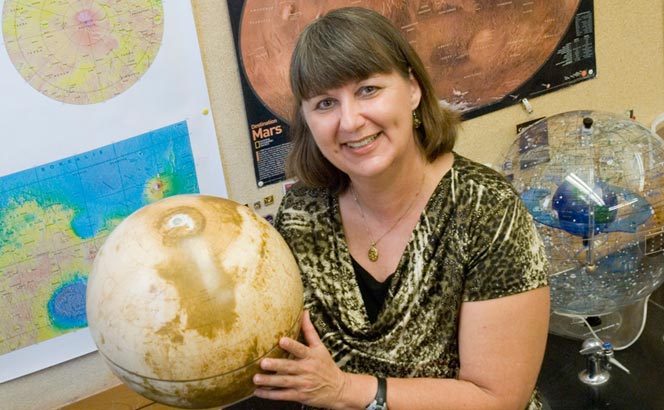by Nadine Barlow
Professor of Physics and Astronomy
An asteroid hurtles from space and strikes the surface of Mars, creating an impact crater. The hit causes a turbulent dust cloud to flow outward, scattering a thin layer of fine-grained material that settles up to 20 times the crater’s radius. Winds normally remove this deposit within a few weeks of its formation. But in certain areas of the planet, the deposits somehow resist erosion and survive for millions of years. What’s the secret behind their longevity?
Our survey of Mars has revealed 140 craters with these unusually thin and widespread deposits. They are associated with small craters found in thick, fine-grained sedimentary deposits—most of which are found in the planet’s ice-rich, mid-to-high latitudes. Based on similar deposits on Earth that are formed around explosive volcanoes and nuclear explosions, it is likely they form when material ejected from the crater strikes the surrounding fine-grained deposits, kicking those small particles up into the turbulent atmospheric flow moving out from the crater. The resulting dust cloud rolls along the surface, eventually settling around the crater as an extensive, thin deposit.
All impact craters on Mars probably form this type of deposit. And normally, it is quickly removed by winds. But those that remain resist erosion due to a thin crust that is formed when salt-laden water evaporates after reaching the surface of the deposit, leaving a salt layer behind. It’s similar to the process we see in dry lakebeds in the desert Southwest. This salty crust protects the deposit from immediate erosion, making it visible to us even millions of years later.
Today Mars is cold and dry, but the fine-grained, ice-rich sediments tell us that the planet undergoes major climate variations over the span of a few million years. When conditions are right, snow and dust can blanket the mid-latitudes, giving rise to the conditions that create and preserve these layered deposits.
Editor’s note: The above blog first appeared on Academic Minute and Inside Higher Ed on Monday, Dec. 16, 2013.



